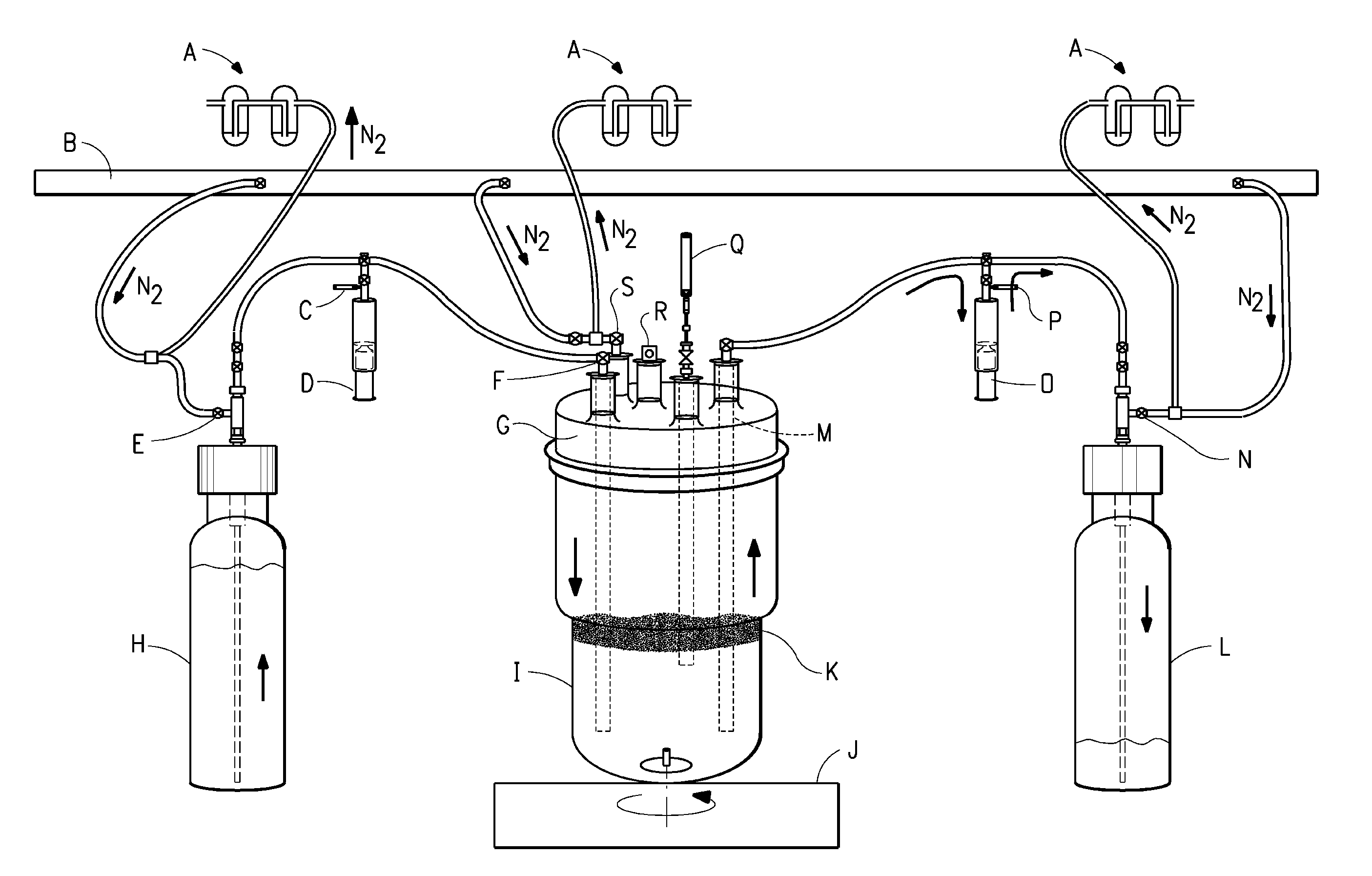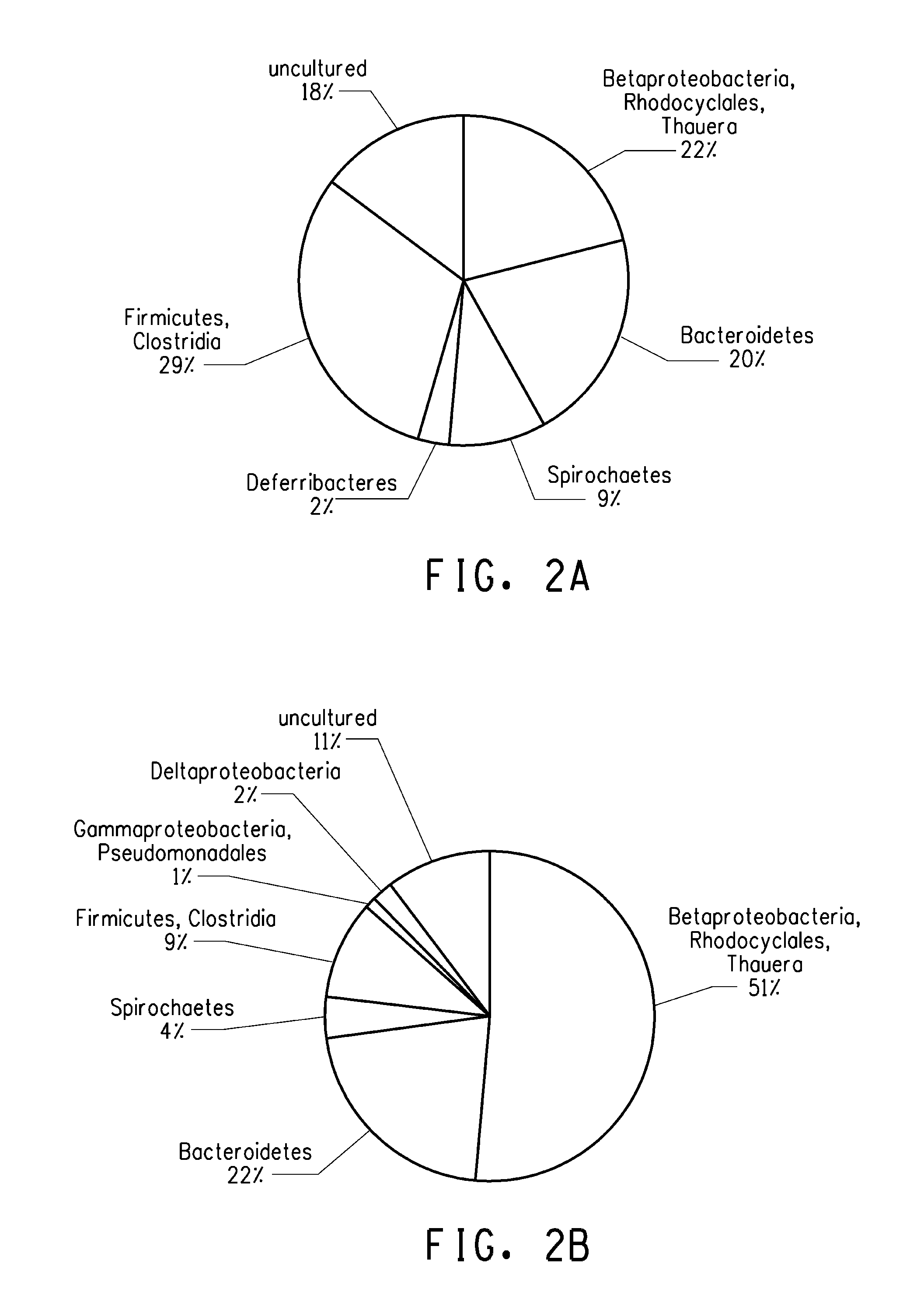Method of in situ bioremediation of hydrocarbon-contaminated sites using an enriched anaerobic steady state microbial consortium
- Summary
- Abstract
- Description
- Claims
- Application Information
AI Technical Summary
Benefits of technology
Problems solved by technology
Method used
Image
Examples
example 1
Enrichment of a Microbial Consortium from an Environmental Sample on Targeted Oil, as the Carbon Source, Under Denitrifying Anaerobic Conditions
Development of the Parent POG1 Consortium
[0156]For the present Example, parent enrichment cultures and a screening protocol were developed to identify microbes capable of growth under anoxic conditions on either crude oil or its components or samples from a hydrocarbon-contaminated site as the sole source of carbon. Nitrate was used as the primary electron acceptor as described herein. Soil samples were diluted at a 1 to 10 w / v ratio (10 g in 100 mL medium) and incubated in the SL10 medium and 250 ppm sodium nitrate as the electron acceptor for 72 hr as described below. These soil suspensions were used as an inoculum into 60 mL serum vials that contained 2:1 v / v of the minimal salts medium (20 mL) and the autoclaved crude oil (10 mL). Inoculations for the enrichment cultures were performed in the Coy anaerobic glove bag as described above. A...
example 2
Monitoring Denitrification and Growth of a Steady State Consortium in a Chemostat Bioreactor
[0160]Growth of the steady state POG1 consortium in the chemostat was monitored by optical density (OD550) and nitrate reduction through taking daily samples for six weeks and then every second to third day for the next nine weeks. The nitrate and nitrite concentrations were determined by ion chromatography as described above. For the first two weeks, nitrate was fed at 14 ppm / day and thereafter at 69 ppm / day. Table 3 shows that equilibrium for nitrate reduction was reached after 9 days, where all of the nitrate, as well as the produced nitrite, were completely reduced. The culture completely reduced its nitrate supply for the next 97 days. Cell density equilibrium was reached after 32 days, two weeks after the nitrate feed had been increased by approximately five fold. The optical densities remained relatively constant for the next 74 days. At 35 to 43 days, the cells started to aggregate to...
example 3
Population Analysis of the Steady State POG1 Consortium and Parent POG1 Cultures Using Cloned 16S rDNA Libraries
[0167]DNA was extracted as described above from the 3rd gen POG1 parent enrichment cultures and from the steady state POG1 chemostat culture samples and used to make cloned 16S rDNA libraries. Briefly, the 1400 base pair 16S rDNA amplification products for a given DNA pool were visualized on 0.8% agarose gels. The PCR reaction mix was used directly for cloning into pPCR-TOPO4 vector using the TOPO TA cloning system (Invitrogen) following the manufacturer's recommended protocol. DNA was transformed into TOP10 chemically competent cells selecting for ampicillin resistance. Individual colonies (˜48-96 colonies) were selected, grown in microtiter plates, prepared and submitted for sequence analysis as described above.
Results of 16S rDNA Sequence Analysis
[0168]An overall 16S profile was compiled for 1st gen, 2nd gen and 3rd gen parent POG1 cultures described herein. 16S rDNA pr...
PUM
 Login to View More
Login to View More Abstract
Description
Claims
Application Information
 Login to View More
Login to View More - R&D
- Intellectual Property
- Life Sciences
- Materials
- Tech Scout
- Unparalleled Data Quality
- Higher Quality Content
- 60% Fewer Hallucinations
Browse by: Latest US Patents, China's latest patents, Technical Efficacy Thesaurus, Application Domain, Technology Topic, Popular Technical Reports.
© 2025 PatSnap. All rights reserved.Legal|Privacy policy|Modern Slavery Act Transparency Statement|Sitemap|About US| Contact US: help@patsnap.com



